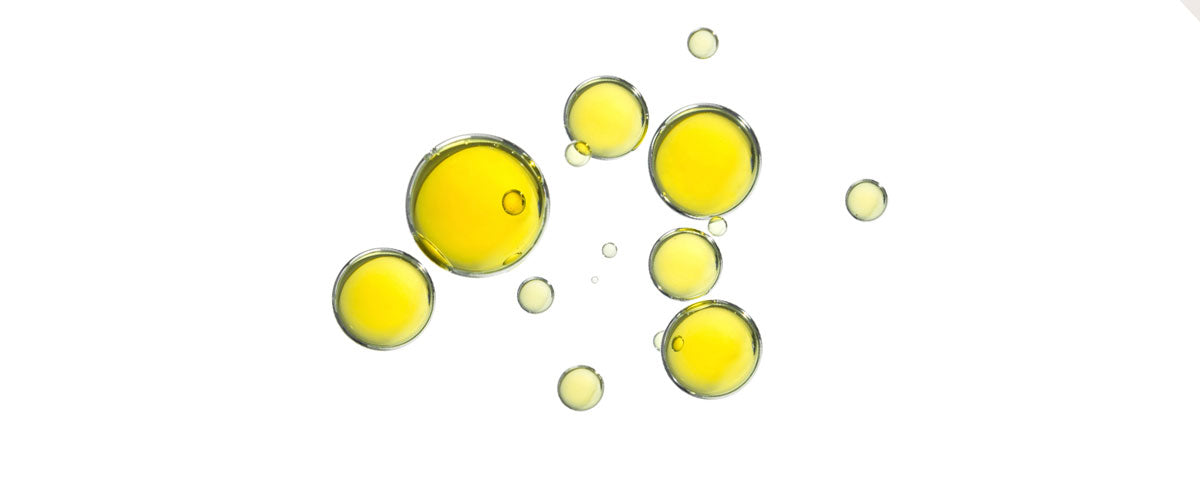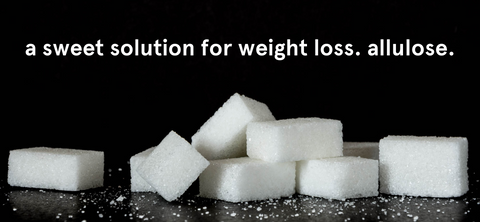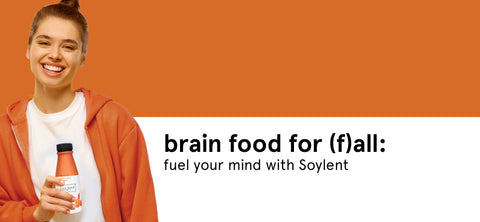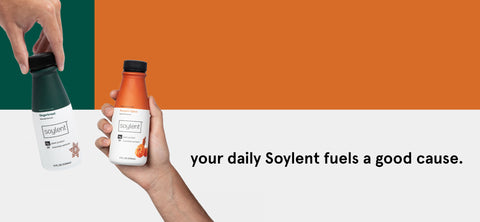
Meal Replacement & Healthy Fats
Whether you are prepping for isolation, too busy to prepare a healthy meal, or looking for ways to track your calories and nutrient intake, meal replacements fill many different needs.
However, all users share the desire to curb their hunger while also getting the right amount of nutrients.
All macronutrients play a role in keeping you feeling full or satiated but they do so in different ways.
In Soylent, we chose to power our formulas with plant protein, slow and fast burning carbohydrates for a steady release of energy and a blend of mostly unsaturated fats.
Unlike many other meal replacements, Soylent is high in fats; 47% of the total calories vs 25% of the total calories coming from fat in the leading meal replacement on the market.
Why so much fat?
We get a lot of comments about this—a lot.
Using fats, the right fats, provide satiety and the essential fatty acids that you might not find in your typical meal replacement drink. Let’s dive in a little deeper.
Using fats to stay full.
For the most part, fat is a slower source of energy. Your body metabolizes it slower than carbohydrates, meaning it helps your body feel fuller for longer periods of time.
Plus, fats are more energy-dense than carbohydrates. Protein and carbohydrates hold 4 calories per gram while fat holds 9 calories per gram. With moderate consumption, fats can be a great way to help you stay on track with daily calorie goals without leaving you feeling deprived or hungry.
The perception around the nutritional value of fats have definitely been shifting in the last few years.
Fat is no longer demonized as a nutrient to avoid as it was in the past. Early satiety research inferred that fat may lead to lower satiety or feeling hungry quicker because it is more energy dense and also really tasty. More recent research shows that fat curbs hunger significantly but that not all fats do and that the quality of the fat and the types of carbohydrates consumed with the fat have a big impact on satiety.(1, 2, 3) Polyunsaturated fats have been shown to slow hunger signaling in the body while saturated fats have been shown to promote hunger. (3) All fats are NOT made equal.
All fats are NOT made equal.
To say all fats are bad or that all fats are good is simply not true. Fats differ in many ways. So, let’s breakdown all types of fat that we see in our diets—the good, the bad, and the ugly.
Saturated Fats
Unsaturated Fats

Omega-9 Fatty Acids
Essential Fatty Acids
Omega 6 Fatty Acids

Omega 3 Fatty Acids
The importance of a balanced omega 6 vs omega 3 ratio.
In the US, people tend to get plenty of omega 6 fatty acids but not enough omega 3 fatty acids.
The ratio of omega 6 to omega 3 in the US is approximately 15/1 whereas we have evolved for a 1:1 ratio according to some sources. (6, 7)
A ratio of 5:1 or lower has been found to have beneficial effects on reducing inflammatory responses and having a positive effect on cardiovascular health and metabolic syndrome prevention. (5, 7, 8)
The idea here is not to reduce or replace omega 6 in your diet since they are beneficial but rather to increase the amount of omega 3 fats you consume.
The ratio of omega-6 to omega-3 fatty acids in Soylent is 4:1 and therefore delivers a balanced ratio of PUFAs to your diet. It’s also a great source of omega 3 if you are looking to up your daily intake.
How much omega 6 and omega 3 do I need per day?
Despite the fact that omega 6 and 3 are essential fatty acids, the FDA has not established a recommended daily value for these nutrients or PUFAs in general.
The National Academy of Dietary Guidelines Advisory Committee issued the recommendation that PUFAs should make up between 5-10% of daily calories. (9, 10) PUFAs make up 8% of the calories in your Soylent drink and therefore within the recommended amount.
There is also no established recommended daily intake for omega 6 and omega 3 by the FDA. However, the World Health Organization (WHO) issued guidance and established an Acceptable Macronutrient Dietary Range (AMDR) based on the evidence available for the health benefits of both Omega 3 and Omega 6 fatty acids. They recommend that omega 6 fats make up 2.5-9% of our calories and that Omega 3 fats make up 0.5-2% of our calories. (11) In Soylent drinks, omega 3 fats make up for just over 1.4% of the calories and omega 6 fats make up for 5.5% of the total calories, well within the recommended range.
Soylent uses canola and high-oleic sunflower oils, which provide omega 3, omega 6 and omega 9 fatty acids. Soylent drinks contain 21 grams of fat, including 19.5 grams of unsaturated fatty acids in every serving. Unlike products made with dairy or other animal protein, our drinks contain less than 10% daily value of saturated fat and zero grams of cholesterol.
Fat is also tasty.
Fat is also key in making our product tasty. Formulating with fats makes the mouthfeel of the product more smooth and creamy by generating a nice emulsion. It also acts as a lubricant by helping the gritty fiber and plant protein to clear from our mouths quickly. In short, it’s a key component of our recipe!
The fat in Soylent is here to stay.
We are working on new innovation and updates for our products but fats are here to stay. We will maintain a high fat level in our products going forward but are looking to bring new healthy plant fats to our products to further improve our fatty acid profile and our sustainability footprint.
References
1. Blundell, J. E. et al. Fat as a risk factor for overconsumption. Journal of the Academy of Nutrition and Dietetics.1997. 97 (7), S63-S69.
2. Erlanson-Albertsson C. Fat-Rich Food Palatability and Appetite Regulation. In: Montmayeur JP, le Coutre J, editors. Fat Detection: Taste, Texture, and Post Ingestive Effects. Boca Raton (FL): CRC Press/Taylor & Francis; 2010. Chapter 14.
3. Lawton, C., Delargy, H., Brockman, J., Smith, F., & Blundell, J. The degree of saturation of fatty acids influences post-ingestive satiety. British Journal of Nutrition. 2000. 83(5), 473-482. doi:10.1017/S000711450000060
4. Forouhi NG, Krauss RM, Taubes G, Willett W. Dietary fat and cardiometabolic health: evidence, controversies, and consensus for guidance. BMJ. 2018;361:k2139
5. J.M. Bourre, Brain lipids and ageing. Technology and Nutrition, Food for the Ageing Population, Woodhead Publishing, 2009,Pages 219-251
6. Molendi-Coste, O., Legry, V., Leclercq, I.A. Why and How Meet n-3 PUFA Dietary Recommendations? Gastroenterol Res Pract. 2011; 2011: 364040.
7. Simopoulos, A. P. The Importance of the Omega-6/Omega-3 Fatty Acid Ratio in Cardiovascular Disease and Other Chronic Diseases. Experimental Biology and Medicine. 2008. 233(6), 674–688.
8. Simopoulos AP, An Increase in the Omega-6/Omega-3 Fatty Acid Ratio Increases the Risk for Obesity Nutrients. 2016 Mar; 8(3): 128.
9. Department of Health and Human Services and the US Department of Agriculture. Dietary Guidelines for Americans: The Report of the Dietary Guidelines Advisory Committee on Dietary Guidelines for Americans, 2005.
10. Institute of Medicine, Food and Nutrition Board. Dietary reference intakes for energy, carbohydrate, fiber, fat, fatty acids, cholesterol, protein, and amino acids (macronutrients). Washington, DC: National Academy Press; 2005.
11. Conclusions and Dietary Recommendations on Total Fat & Fatty Acids. Joint FAO/WHO Expert Consultation on Fats and Fatty Acids in Human Nutrition, 10-14 November, 2008, WHO, Geneva

Julie Daoust, PhD, Soylent VP Product Development & Innovation







